BIS, Bank of England Introduce a New Tool to Track Stablecoin Reserves
The Bank for International Settlements (BIS) and the Bank of England are running a project that allows the tracking of stablecoin reserves in real-time.
UK financial watchdogs are seeking better oversight of the crypto space, with a special interest in stablecoins, which remain a contentious sector in the industry.
UK Financial Authorities Unveil Pyxtrial For Better OversightBeyond stablecoins’ liabilities and their backed assets, Pyxtrial could also apply to other tokenized products backed by Real-World Assets (RWA). It will enable them to directly extract data from users’ systems for on-chain liability verification.
“The technology is a first step towards a tool that could support supervisors and regulators in proactively detecting issues in stablecoin backing. It will aid the development of policy frameworks based on integrated data. Pyxtrial explores how technology solutions can enable the monitoring of asset-backed stablecoins’ balance sheets. It provides insight into whether the backing assets exceed their liabilities at all times,” the announcement read.
However, Pyxtrial is still in the testing stage before being fully deployed in the market. The system will also require personnel training to operate.
Read more: Crypto Regulation: What Are the Benefits and Drawbacks?
The UK watchdog has expressed concern over the validity of the reserves that stablecoin issuers claim to back their holdings. This follows a period of disorderly engagement between financial authorities and stablecoin issuers.
Amid the back-and-forth, some issuers, like Tether, and even exchanges, such as Binance, resorted to self-regulation. For the most part, the watchdog’s concern sprouted from the FTX implosion, compelling exchanges to disclose proof of reserves as if to assuage the authorities.
DefiLlama data shows that stablecoins are a growing sector in the crypto market, with a market capitalization of $164.02 billion. Amid this fast-paced growth, concerns arise as they remain a largely unregulated sector.
 Stablecoin Market Capitalization, Source: DefiLlama
Stablecoin Market Capitalization, Source: DefiLlama
Stablecoin usage has alarmed regulators, especially regarding disclosures and potential instability during market stress. SEC Chair Gary Gensler has stated that he believes some stablecoins qualify as securities. He has proposed registration and additional regulatory oversight to address these concerns.
In 2023, for example, the US SEC targeted Binance US stablecoin (BUSD) over securities claims. This sent shock waves across the market, hinting at what dollar-pegged tokens could draw regulatory attention and investigation. Nevertheless, the regulator recently dropped the charges after a court ruling favored Binance, stating that BUSD sales were not a securities offering.
This verdict strengthened the stablecoin sector in the US, just as Pyxtrial could improve the situation in the UK stablecoin market.
The post BIS, Bank of England Introduce a New Tool to Track Stablecoin Reserves appeared first on BeInCrypto.
